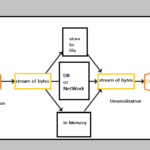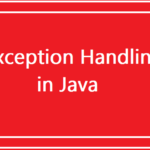Encapsulation is a fundamental concept in Java programming that plays a pivotal role in building robust and maintainable software. It is one of the four pillars of Object-Oriented Programming (OOP) principles, alongside inheritance, polymorphism, and abstraction. In this multipart series, we will delve into the depths of encapsulation, exploring its definition, significance, and implementation in Java.
What is Encapsulation?
At its core, encapsulation is the bundling of data (attributes) and methods (functions) that operate on the data into a single unit known as a class. The key idea is to encapsulate the internal details of a class, exposing only what is necessary for the outside world to interact with. This shields the internal implementation from external interference and manipulation.
The Basics: Attributes and Methods
In Java, a class is a blueprint for creating objects. Objects, in turn, are instances of a class, embodying both data and behavior. Encapsulation ensures that the internal state (attributes) of an object is kept private and can only be accessed or modified through well-defined methods.
Consider a simple example of a Car class:
public class Car {
private String model;
private int year;
private double price;
// Constructors, getters, setters, and other methods go here
}In this example, the model, year, and price attributes are marked as private, meaning they are not directly accessible from outside the Car class. This is the first line of defense provided by encapsulation.
Why Encapsulation?
1.Data Hiding:
Encapsulation facilitates data hiding by restricting access to the internal state of an object. Private attributes cannot be directly manipulated from outside the class, enhancing data security.
2.Flexibility and Maintenance:
By encapsulating the internal details of a class, developers can modify the class’s implementation without affecting the code that uses the class. This enhances code maintainability and allows for easier updates.
3.Controlled Access:
Getter and setter methods provide controlled access to the private attributes. This controlled access allows for additional logic, such as validation checks, to be incorporated when retrieving or modifying data.
4.Preventing Unintended Modifications:
Encapsulation prevents unintended modifications to the internal state of an object. External code is forced to interact with the object through well-defined methods, reducing the risk of accidental errors.
Access Modifiers in Java
Java offers four access modifiers: public, private, protected, and the default (package-private). These modifiers determine the visibility of classes, methods, and attributes within and outside the class and package. In the context of encapsulation, the private access modifier is particularly crucial.
private:
Attributes or methods marked as private are accessible only within the class they are declared in. They cannot be accessed directly from outside the class.
public class Car {
private String model;
private int year;
private double price;
// Constructors, getters, setters, and other methods go here
}Here, model, year, and price are private attributes of the Car class.
Getter and Setter Methods
While encapsulation restricts direct access to attributes, it provides controlled access through getter and setter methods.
Getter Methods:
Getter methods are public methods that retrieve the values of private attributes. They provide read-only access to the encapsulated data.
public class Car {
private String model;
private int year;
private double price;
// Getter methods
public String getModel() {
return model;
}
public int getYear() {
return year;
}
public double getPrice() {
return price;
}
}External code can access the attributes only through these getter methods.
Setter Methods:
Setter methods, on the other hand, allow external code to modify the values of private attributes. They provide a controlled way to update the internal state of an object.
public class Car {
private String model;
private int year;
private double price;
// Setter methods
public void setModel(String model) {
this.model = model;
}
public void setYear(int year) {
this.year = year;
}
public void setPrice(double price) {
this.price = price;
}
}Setter methods often include validation logic to ensure that the new values meet certain criteria.
Benefits of Getter and Setter Methods
- Controlled Modification:
- Setter methods enable controlled modification of attributes. They act as gatekeepers, allowing or disallowing changes based on defined rules.
- Encapsulating Logic:
- Getter and setter methods encapsulate the logic associated with attribute access and modification. This encapsulation helps in maintaining a clean and organized codebase.
- Facilitating Future Changes:
- As the internal representation of data might change over time, using getter and setter methods shields external code from such modifications. This contributes to code flexibility and adaptability.
Scenario 1: Data Validation with Setter Methods
One of the key advantages of encapsulation is the ability to incorporate data validation logic within setter methods. Consider a scenario where we want to ensure that the price of a Car object is always non-negative. Encapsulation allows us to enforce this rule without compromising the internal state of the object:
public class Car {
private String model;
private int year;
private double price;
// Constructors, getters, setters, and other methods go here
// Setter method with data validation
public void setPrice(double price) {
if (price >= 0) {
this.price = price;
} else {
//Here you can throw custom exception too
System.out.println("Invalid price value. Price cannot be negative.");
}
}
}Scenario 2: Modifying Internal Representation
Encapsulation allows developers to modify the internal representation of a class without affecting external code. Consider an enhancement where we decide to store the year as a String instead of an int. With encapsulation, we can make this change within the class:
public class Car {
private String model;
private String year;
private double price;
// Constructors, getters, setters, and other methods go here
}
External code that uses the Car class remains unaffected. The encapsulation of the internal details shields external code from changes made for improved implementation.
Scenario 3: Controlled Access to Attributes
In a complex software system, different components interact with each other. Encapsulation helps in maintaining a clear interface between these components. Consider a scenario where a Car class is part of a larger system, and only certain attributes need to be accessed by external modules:
public class Car {
private String model;
private String make; // Newly added attribute
private int year;
private double price;
// Constructors, getters, setters, and other methods go here
// Getter method for 'make'
public String getMake() {
return make;
}
}Here, the make attribute is added, and a specific getter method is provided to grant controlled access to this new attribute. This encapsulation ensures that only the necessary information is exposed to external code.
Best Practices
- Keep Attributes Private:
- Mark attributes as
privateby default and only expose what is necessary. This minimizes direct access and promotes data hiding.
- Provide Getter and Setter Methods:
- When encapsulating attributes, provide getter and setter methods to control access and modification. Include validation logic in setter methods to maintain data integrity.
- Encapsulate Related Functionality:
- Group related attributes and methods together within a class. This promotes a clear and organized structure, making the code more maintainable.
- Consider the External Interface:
- When designing a class, think about the external interface it will provide to other components. Only expose the essential information to maintain a clean interface.
- Document Public API:
- Clearly document the public API of your classes, specifying which methods and attributes are intended for external use. This documentation serves as a guide for developers interacting with your code.
When to Use Encapsulation
In Large and Complex Systems
- Encapsulation is particularly beneficial in large and complex software systems where maintaining a clear interface between components is crucial.
For Code Reusability
- Encapsulation promotes code reusability by encapsulating related functionality within a class. This makes it easier to reuse classes in different parts of the codebase.
For Enhancing Security
- By restricting direct access to internal state, encapsulation enhances security by preventing unintended modifications and ensuring that data is accessed and modified only through controlled methods.
When to Be Cautious
In Simple and Small-Scale Programs:
- For small and straightforward programs, the overhead of encapsulation might outweigh the benefits. It’s essential to strike a balance and not introduce unnecessary complexity.
Avoid Overuse of Getters and Setters:
- While getter and setter methods are powerful tools, avoid overusing them. Exposing too many details of an object’s internal state can lead to a less encapsulated design.
Encapsulation is a cornerstone of Java programming and OOP in general. By encapsulating data and methods within a class, Java developers can create more secure, flexible, and maintainable software. Understanding the principles and best practices of encapsulation is essential for building robust and scalable applications.
Happy Coding…


